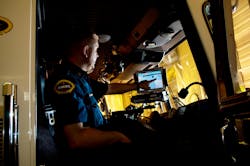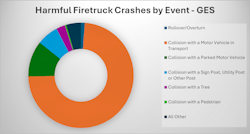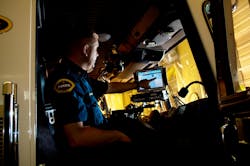Maximizing Safety to Minimize Risk When Responding to Emergencies
When the alarm sounds, firefighters move swiftly to respond to an emergency. The fire engine departs the station, lights flashing and sirens blaring to signal its presence on the road. As it navigates busy streets, weaving through traffic and bypassing obstacles, the urgency of the situation demands full attention and precise coordination. Despite the right-of-way and clear visual and auditory signals, other road users may fail to yield appropriately. In an instant, a collision occurs, halting progress and jeopardizing the timely arrival at the emergency scene.
Firefighters routinely respond to some of the most critical and high-pressure situations we may face in our lives. However, the urgency with which they must navigate urban environments presents significant challenges. Along with dense traffic and crowded pedestrian areas at high speeds, the considerable size and weight of fire engines further complicates maneuverability and braking.
The National Library of Medicine estimates 15,675 fire department vehicles were involved in traffic accidents, resulting in 550 firefighter injuries and 7 firefighter fatalities. They state that crashes are the second-leading cause of death or injury for on-duty firefighters.
Harmful Firetruck Crashes by Event Type – Source GES
These accidents not only adversely affect the person injured and the family, but they also affect the bottom line. According to Fire Apparatus Manufacturers Association the cost of emergency vehicle accidents in the United States is estimated to be as much as $35 billion annually between direct collision costs, medical costs, vehicle replacements and repairs, workplace and insurance costs, lawsuits, property and equipment damage, disability pay, retraining pay, and the many other expenses that can arise.
What can be done to protect our first responders when they travel to an event?
In the world of first responders, even a second can determine the outcome between saving a life or losing a life. How can firetruck operators gain those crucial extra seconds and the information they need to get to their call quickly and safely?
One constant recommendation is adding safety technology to your fleet. Implementing these systems not only supports safer navigation through dense urban environments but also improves situational awareness, allowing operators to make informed decisions under pressure.
These include:
- Vision Systems: Whether you add a single reversing camera or a 360-vision system, the truck operator has a better view of his surrounding by eliminating the many blind spots in these large machines, allowing the driver to focus on the road.
- Today’s vision system can see further, can integrate with AI detection to alert the operator when a pedestrian is in their path and even provide notification during forward maneuvers.
- Object Detection Systems: These technologies include an audible alert when there is something in the blind spot. In addition, many have been enhanced with advanced capabilities such as artificial intelligence to determine if the object is a bicyclist, forward collision alerts, and more. Many will work with your Firetruck builder to integrate with your CAN connection for other triggers and/or to even slow down the truck when reversing when a detection occurs. Adding these systems adds that critical second or two to give the driver time to react when others sharing the road are becoming obstacles.
- Dashboard Cameras / Recorders: These systems were initially built to provide video proof if an incident occurs. In addition, real-world video is a proactive training tool for new operators as well as reminders for those more seasoned.
Our first responders have so much to focus on when called to an incident, let’s do what we can to ensure they arrive safely.
About Brigade Electronics
Brigade Electronics provide the above safety technologies, along with many more, to provide operators with the extra second or two they need to save lives. Our engineering team has designed these systems based on the environment, vehicle type, maneuverability, and work site conditions. Our team is happy to assist you in building the safety solution that best fits your needs and requirements. Learn more at brigade-inc.com.









